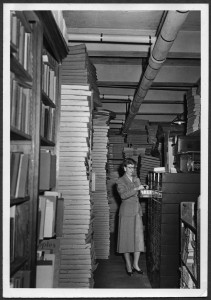Happy Birthday to the Temple of Justice!
 From the desk of Sean Lanksbury. PNW & Special Collections Librarian
From the desk of Sean Lanksbury. PNW & Special Collections Librarian
Today marks Centennial Celebration of the Washington State Temple of Justice building, home to the State Supreme Court. The Temple is also home to the Washington State Law Library, but did you know that the building also housed the Washington State Library for 45 years? This excerpt, taken from “Historic Sites of the Washington State and Territorial Library: 1853 to the present,” tells more…
In 1913, the library collection’s were relocated “temporarily” (from the Old State Capitol Building) to five small rooms in the basement of the Temple of Justice, with the rarest items placed into a vault. The Temple of Justice, home of the Washington State Supreme Court, is the oldest building of the Wilder and White capitol plan on the Capitol grounds, dating back to 1912. Though started in 1912, construction was not fully completed until 1920 due to issues with construction financing. Upon completion of the Legislative Building, the library was supposed to move into dedicated space there. This plan was never realized for when the Legislative Building was completed in 1928, the spaces had already been taken over by other state agencies. Other plans for relocating the collection were devised over the years: moving the collection back to the Old State Capitol Building following a remodel, into “available space” in the General Administration Building, or into a remodeled Labor and Industries Building. All proposals were rejected, often because the costs were close to or the same as creating an entirely new dedicated facility.
Changes and growth began to occur at the library during its stay at the Temple. In February of 1933 State Librarian Mildred Pope established an official Legislative Reference Service. In 1939, portions of the Daughters of Pioneer Collection were relocated and housed at the Washington State Library, including the McCardle index. In 1941 the Washington State Library Commission was created. It had five members: four appointed by Governor, with the Superintendent of Public Instruction as the fifth. In 1944 legal responsibility was vested in the Library Commission, which adopted a Statement of Policy on January 20, 1944. In 1948 the Washington Library Association wrote a proposal for an Institutional Library Program for Washington State Institutions. This proposal advanced the idea of a cooperative arrangement between the Department of Institutions and the Washington State Library for reading and reference services. For many years the proposal would be discussed without any concrete partnership materializing. In 1951 the library also partnered with the State Archives to initiate the microfilming of archival newspapers and manuscript files. By March 2, 1953, the library’s 100th anniversary, 271,700 volumes were listed in the collection. Though it was cramped for space and the collections were in serious peril, the library put on a brave face; celebrating its centennial with a tea and open house for dignitaries.
Note: The Washington State Library was a division of the Department of Education at one time.
In 1955 The Tacoma News Tribune described the legislative treatment of the library as akin to being the “stepchild of state government.” It reported on the inappropriate quarters and the neglectful condition of the library. What follows is one passage from the article:
Housed in congested quarters in the basement of the Temple of Justice at Olympia is the Washington State Library which has become a maze of confusion because of lack of space. Irreplaceable books and papers are in danger of destruction because they cannot be given proper care…rare historical documents and newspaper files share space with office files under steam and water pipes. Much of this material is deteriorating faster than staff members can repair it. … No public reading space is available, books are piled high and narrow aisles are often completely blocked.
Despite the dire conditions and poor public perception, a glint of optimism was in the air. A new library bill garnering strong political support from members of both major parties was introduced that year. The proposal was to create a separate and dedicated building as part of the Capitol Campus. This building would be funded from the state building fund, which received money from the sale of timber on state-owned lands, removing the need for new taxes to be raised.
More information on the history of the State Library can be found on our website and in the book Dynamics of Change, by former State Librarian Maryan E. Reynolds (also pictured above).